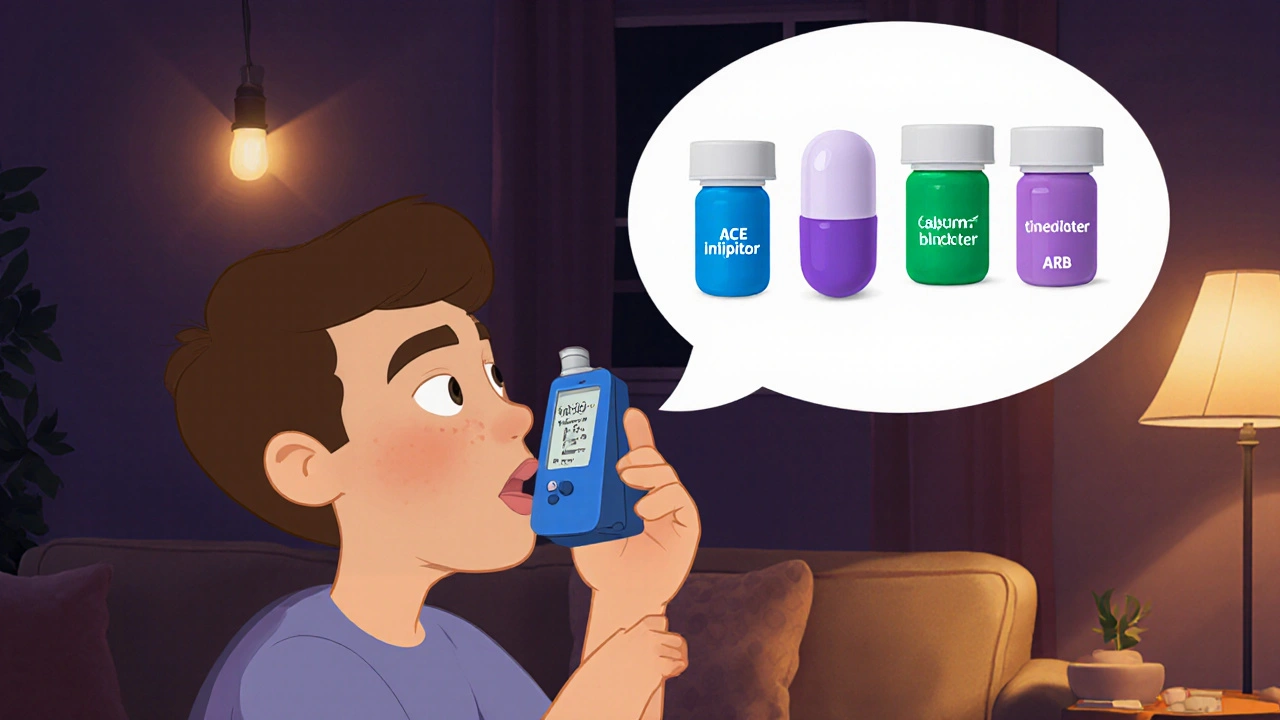Atenolol and Asthma Safety: What Asthmatics Need to Know
 Oct, 23 2025
Oct, 23 2025
Atenolol Dose Safety Calculator
Is Your Atenolol Dose Safe for Asthma?
This tool helps you determine if your atenolol dosage is likely safe based on your asthma severity. Always consult your healthcare provider before making any medication changes.
Key Takeaways
- Atenolol is a selective beta‑1 blocker, which means it mainly affects the heart and has a lower risk of breathing problems compared with non‑selective beta blockers.
- Most clinical guidelines consider atenolol safe for mild‑to‑moderate asthma when used at low doses, but careful monitoring is essential.
- If you have severe asthma or a history of bronchospasm, discuss alternative blood‑pressure drugs such as ACE inhibitors or calcium‑channel blockers with your doctor.
- Always inform any prescriber that you have asthma - even if you’re feeling fine - because dosage adjustments may be needed.
- Watch for warning signs like wheezing, shortness of breath, or increased rescue‑inhaler use after starting atenolol and seek medical help promptly.
What Is Atenolol?
Atenolol is a cardio‑selective beta‑1 adrenergic blocker commonly prescribed for hypertension, angina, and certain arrhythmias. By blocking beta‑1 receptors in the heart, it reduces heart rate and contractility, lowering blood pressure without strongly affecting beta‑2 receptors in the lungs.
Because it is “cardio‑selective,” atenolol is often the first‑line beta blocker for patients who also have respiratory conditions. However, selectivity is dose‑dependent - higher doses can spill over to beta‑2 receptors, potentially narrowing the airways.
Understanding Asthma
Asthma is a chronic inflammatory disease of the airways that makes them hyper‑responsive to triggers such as allergens, cold air, or exercise. The inflammation leads to bronchoconstriction, mucus production, and airway remodeling, which manifest as wheezing, coughing, and shortness of breath.
Effective asthma control relies on inhaled corticosteroids, bronchodilators, and avoidance of triggers. Any medication that may provoke bronchoconstriction must be evaluated carefully.

Beta‑Blockers and the Respiratory System
Beta blockers fall into two broad classes:
- Non‑selective beta blockers (e.g., propranolol) block both beta‑1 and beta‑2 receptors, increasing the risk of bronchospasm in asthmatics.
- Cardio‑selective beta blockers (e.g., atenolol, metoprolol) preferentially block beta‑1 receptors, preserving most beta‑2‑mediated bronchodilation.
The degree of selectivity matters. Studies show that atenolol’s affinity for beta‑2 receptors is about 10‑fold lower than for beta‑1 receptors, making it safer for patients with mild‑to‑moderate asthma. Nevertheless, at doses above 100 mg daily, the selectivity gap narrows, and bronchospasm can occur.
Is Atenolol Safe for Asthmatics? Evidence and Guidelines
Several sources address this question directly:
- British National Formulary (BNF) notes that cardio‑selective beta blockers can be used in asthmatics with caution, emphasizing low‑dose initiation.
- NICE guideline NG136 (2022) recommends a trial of low‑dose atenolol for hypertension in patients with controlled asthma, provided they are monitored for respiratory symptoms.
- A 2019 systematic review from the American Journal of Respiratory and Critical Care Medicine analyzed 12 studies involving over 3,000 asthmatic patients. The pooled data showed no increase in severe exacerbations when atenolol was used at ≤50 mg/day, but a modest rise in mild symptoms at higher doses.
Key take‑aways from the evidence:
- Low‑dose atenolol (≤50 mg) is generally well‑tolerated in patients with mild‑to‑moderate asthma.
- Patients with severe, uncontrolled asthma should avoid atenolol unless no alternatives exist.
- Close follow‑up within the first two weeks of therapy is critical to catch any early bronchospasm.

Practical Tips for Patients
- Start low, go slow: Begin with 25 mg daily and titrate upward only if blood pressure remains high and you experience no breathing issues.
- Use a peak‑flow meter: Record baseline readings before starting atenolol and repeat after the first week. A drop of more than 10% warrants a doctor’s review.
- Keep rescue inhaler handy: If you notice wheezing after a dose, use your short‑acting bronchodilator and note the timing.
- Communicate with all providers: Make sure your cardiologist, primary‑care physician, and asthma specialist all know you’re on atenolol.
- Report side‑effects immediately: Tight chest, persistent cough, or increased nighttime asthma symptoms should trigger a medical call.
Alternative Blood‑Pressure Options for Asthmatics
If atenolol isn’t appropriate, consider these classes:
| Medication Class | Typical Use | Asthma Risk |
|---|---|---|
| ACE Inhibitors (e.g., lisinopril) | Hypertension, heart failure | Low - may cause cough, not bronchospasm |
| Calcium‑Channel Blockers (e.g., amlodipine) | Hypertension, angina | Very low - no effect on beta receptors |
| ARBs (e.g., losartan) | Hypertension, diabetic nephropathy | Low - well‑tolerated in asthma |
| Selective Beta‑1 Blockers (e.g., metoprolol) | Similar to atenolol | Low at low doses, similar caution |
| Non‑selective Beta Blockers (e.g., propranolol) | Migraine, essential tremor | High - generally avoided in asthma |
Discuss these alternatives with your clinician to find a regimen that balances cardiovascular control and respiratory safety.
Frequently Asked Questions
Can I take atenolol if I have occasional asthma attacks?
Yes, most doctors will prescribe a low dose of atenolol if your asthma is well‑controlled and you don’t experience frequent attacks. Regular monitoring is still required.
What dose of atenolol is considered safe for asthma?
Clinical data suggest that 25‑50 mg once daily is generally safe for mild‑to‑moderate asthma. Doses above 100 mg increase the chance of bronchoconstriction.
Will atenolol make my existing inhalers less effective?
Atenolol does not interfere with the pharmacology of short‑acting beta‑2 agonists (e.g., albuterol). However, if bronchospasm does occur, you may need to use your rescue inhaler more often.
Are there any warning signs I should watch for after starting atenolol?
Watch for new wheezing, tight chest, increased use of rescue inhaler, or nighttime coughing. If any appear, contact your healthcare provider right away.
Can I switch from a non‑selective beta blocker to atenolol safely?
Switching should be done under medical supervision. A gradual taper of the non‑selective agent while introducing low‑dose atenolol helps minimize rebound hypertension and respiratory irritation.
Remember, every person’s situation is unique. The information here is a guide, not a substitute for personalized medical advice.
Dan Danuts
October 23, 2025 AT 19:20Great rundown-looks like atenolol can be safe if we play it smart!
Dante Russello
October 24, 2025 AT 17:33When you start a beta‑blocker like atenolol, it’s crucial to check your baseline peak‑flow so you have a reference point. A drop of more than 10 % from that baseline often signals the drug is nudging the airways. Most studies show that doses up to 50 mg daily keep the beta‑1 selectivity high enough to spare the lungs. However, once you breach the 100 mg threshold, the selectivity gap narrows, and beta‑2 receptors may feel the pinch. That’s why the “start low, go slow” mantra works so well in practice. In real‑world clinics, doctors typically begin at 25 mg and schedule a follow‑up within two weeks. During that visit they’ll ask about wheezing, nighttime cough, and rescue‑inhaler usage. If everything looks steady, a cautious uptick to 50 mg can be considered. Patients with mild‑to‑moderate asthma generally tolerate that increase without trouble. Conversely, anyone with frequent exacerbations should stay at the lowest effective dose or explore alternatives. Alternatives like ACE inhibitors, calcium‑channel blockers, or ARBs have negligible impact on beta‑2 receptors. Even metoprolol, another cardio‑selective blocker, follows the same dose‑dependent rules. Remember that inhaled corticosteroids remain the backbone of asthma control, regardless of your blood‑pressure meds. If you ever notice a new wheeze after a dose, grab your rescue inhaler and record the timing. Finally, always inform every prescriber-your cardiologist, primary‑care doc, and pulmonologist-about your asthma status, because coordination prevents surprises.
James Gray
October 25, 2025 AT 15:46I totally get why many of us worry about beta‑blockers, but the data really show that low‑dose atenolol is often fine for controlled asthma. It’s easy to forget to mention asthma to every specialist, especially when you’re juggling appointments. Just keep a notebook of your peak‑flow numbers and bring it along, and you’ll have solid evidence if anything changes.
Scott Ring
October 26, 2025 AT 13:00From my experience, setting a reminder to check your inhaler use after the first week helps catch any subtle changes before they become a full‑blown flare‑up. It’s a small habit that pays off big time.
Shubhi Sahni
October 27, 2025 AT 11:13One must, however, always remember, that communication is key; inform every healthcare provider-cardiologist, primary‑care physician, and pulmonologist-about the presence of asthma, especially when initiating atenolol; this ensures dosage adjustments are made promptly, and potential side‑effects are monitored diligently.
Danielle St. Marie
October 28, 2025 AT 09:26Honestly, prescribing atenolol to an asthmatic without a thorough review is borderline negligent 🙄. The elite circles of cardiology know better, and we, the informed patients, demand evidence‑based practice! 💪🚀
keerthi yeligay
October 29, 2025 AT 07:40Check your peak flow before and after startin atenolol; if it drops >10% re-evaluate.
Peter Richmond
October 30, 2025 AT 05:53Commencing atenolol at 25 mg daily, monitoring for respiratory symptoms, and escalating only upon stable hemodynamic response aligns with guideline‑directed therapy.
Bonnie Lin
October 31, 2025 AT 04:06Keep track of inhaler puffs after each dose.
sara fanisha
November 1, 2025 AT 02:20Stay positive-most folks do just fine with a low dose, and you’ll still get the blood‑pressure benefits.
Tristram Torres
November 2, 2025 AT 00:33That’s a solid point.
Jinny Shin
November 2, 2025 AT 22:46Alas, the very notion that a heart‑focused drug could betray the lungs shudders the soul of any diligent patient, echoing a tragedy penned by the gods of medicine themselves.
deepak tanwar
November 3, 2025 AT 21:00While dramatics abound, the empirical literature remains unequivocal: atenolol, when dosed appropriately, does not constitute a statistically significant risk factor for exacerbations in well‑controlled asthma cohorts.